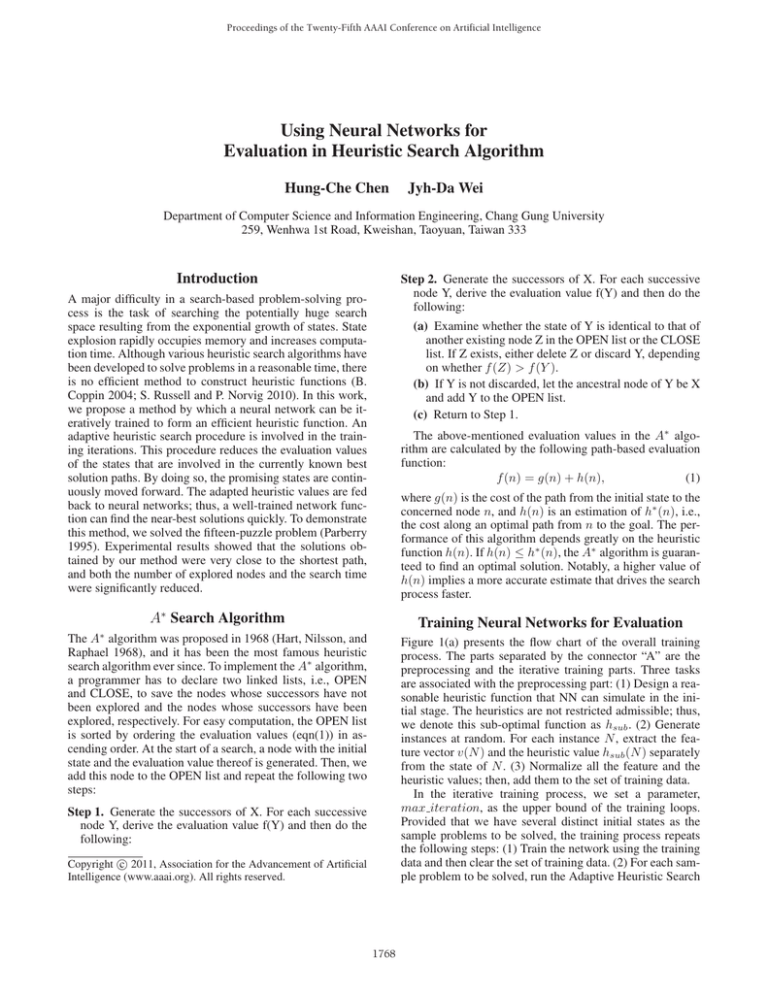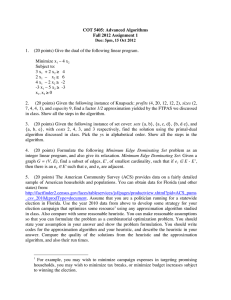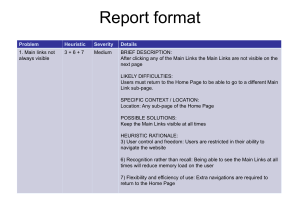
Proceedings of the Twenty-Fifth AAAI Conference on Artificial Intelligence
Using Neural Networks for
Evaluation in Heuristic Search Algorithm
Hung-Che Chen
Jyh-Da Wei
Department of Computer Science and Information Engineering, Chang Gung University
259, Wenhwa 1st Road, Kweishan, Taoyuan, Taiwan 333
Introduction
Step 2. Generate the successors of X. For each successive
node Y, derive the evaluation value f(Y) and then do the
following:
A major difficulty in a search-based problem-solving process is the task of searching the potentially huge search
space resulting from the exponential growth of states. State
explosion rapidly occupies memory and increases computation time. Although various heuristic search algorithms have
been developed to solve problems in a reasonable time, there
is no efficient method to construct heuristic functions (B.
Coppin 2004; S. Russell and P. Norvig 2010). In this work,
we propose a method by which a neural network can be iteratively trained to form an efficient heuristic function. An
adaptive heuristic search procedure is involved in the training iterations. This procedure reduces the evaluation values
of the states that are involved in the currently known best
solution paths. By doing so, the promising states are continuously moved forward. The adapted heuristic values are fed
back to neural networks; thus, a well-trained network function can find the near-best solutions quickly. To demonstrate
this method, we solved the fifteen-puzzle problem (Parberry
1995). Experimental results showed that the solutions obtained by our method were very close to the shortest path,
and both the number of explored nodes and the search time
were significantly reduced.
(a) Examine whether the state of Y is identical to that of
another existing node Z in the OPEN list or the CLOSE
list. If Z exists, either delete Z or discard Y, depending
on whether f (Z) > f (Y ).
(b) If Y is not discarded, let the ancestral node of Y be X
and add Y to the OPEN list.
(c) Return to Step 1.
The above-mentioned evaluation values in the A∗ algorithm are calculated by the following path-based evaluation
function:
f (n) = g(n) + h(n),
(1)
where g(n) is the cost of the path from the initial state to the
concerned node n, and h(n) is an estimation of h∗ (n), i.e.,
the cost along an optimal path from n to the goal. The performance of this algorithm depends greatly on the heuristic
function h(n). If h(n) ≤ h∗ (n), the A∗ algorithm is guaranteed to find an optimal solution. Notably, a higher value of
h(n) implies a more accurate estimate that drives the search
process faster.
A∗ Search Algorithm
Training Neural Networks for Evaluation
The A∗ algorithm was proposed in 1968 (Hart, Nilsson, and
Raphael 1968), and it has been the most famous heuristic
search algorithm ever since. To implement the A∗ algorithm,
a programmer has to declare two linked lists, i.e., OPEN
and CLOSE, to save the nodes whose successors have not
been explored and the nodes whose successors have been
explored, respectively. For easy computation, the OPEN list
is sorted by ordering the evaluation values (eqn(1)) in ascending order. At the start of a search, a node with the initial
state and the evaluation value thereof is generated. Then, we
add this node to the OPEN list and repeat the following two
steps:
Figure 1(a) presents the flow chart of the overall training
process. The parts separated by the connector “A” are the
preprocessing and the iterative training parts. Three tasks
are associated with the preprocessing part: (1) Design a reasonable heuristic function that NN can simulate in the initial stage. The heuristics are not restricted admissible; thus,
we denote this sub-optimal function as hsub . (2) Generate
instances at random. For each instance N , extract the feature vector v(N ) and the heuristic value hsub (N ) separately
from the state of N . (3) Normalize all the feature and the
heuristic values; then, add them to the set of training data.
In the iterative training process, we set a parameter,
max iteration, as the upper bound of the training loops.
Provided that we have several distinct initial states as the
sample problems to be solved, the training process repeats
the following steps: (1) Train the network using the training
data and then clear the set of training data. (2) For each sample problem to be solved, run the Adaptive Heuristic Search
Step 1. Generate the successors of X. For each successive
node Y, derive the evaluation value f(Y) and then do the
following:
c 2011, Association for the Advancement of Artificial
Copyright Intelligence (www.aaai.org). All rights reserved.
1768
Adaptation occurs when we explore a successive node,
X, and the state of this node is verified to be included in the
currently known shortest path. In this case, we reduce the
evaluation value of X as
f (X) = p fˆ(X) + (1 − p) fmin
and replace the heuristic value of X with
h(X) = f (X) − g(X),
(6)
(7)
where fmin is the minimum of the evaluation values
among all OPEN nodes, and p (0 ≤ p ≤ 1) is the adaptation
ratio, referred to as the “promotion rate.” After adaptation,
we return to step 2(a) of the A∗ algorithm, i.e., we insert X
in the OPEN list.
Experimental Results and Conclusion
Using the fifteen-puzzle problem as an example,the solutions obtained by our method are very close to the shortest path and both the explored nodes and the searching
time are significantly reduced. According to a literature survey, similar methods to train a neural network for heuristic search have been presented (Boyan and Moore 2001;
Chellapilla and Fogel 1999). However, these methods have
to find the best solutions first, such that the cost of the optimal path from the concerned state to the goal can be considered as the target value for training the neural network.
The requirement of finding the best solutions implies the necessity of constructing an admissible heuristic function for
performing a search in the first stage. If we can find only suboptimal solutions by using non-admissible heuristics, the capability of the neural network is restricted to approximating
the cost leading to sub-optimal solutions.
Figure 1: The proposed method. (a) Flow chart of the overall
training process. (b) Adaptive heuristic search (AHS).
(AHS) procedure. This procedure uses the neural network
designed by us to generate the heuristic value hN N ; nevertheless, heuristic values can be further adjusted during the
search process. (3) Once a sample problem has been solved,
record all the feature vectors and the heuristic values (could
be adjusted) from the nodes in the CLOSE list. Add these
values to the set of training data after normalization and then
repeat the steps listed above.
Acknowledgment
This work was supported by the National Science Council
under the Grant NSC99-2628-E-182-051, advised by JyhDa Wei, who is the advisor of Hung-Che Chen and also the
corresponding author of this work.
Adaptive Heuristic Search
Figure 1(b) presents the kernel of our training method, i.e.,
the adaptive heuristic search (AHS) procedure. This procedure is modified from the A∗ algorithm and also involves the
use of the OPEN and the CLOSE lists. The heuristic function of AHS, denoted as hN N , is built upon a feedforward
neural network. For each search node N , we extract the feature vector v(N ) from the state of the node, normalize the
feature, and send it to the network. Assuming that the output
is A(N ), the heuristics are given by
hN N (N ) = 2(1/A(N ))
References
B. Coppin. 2004. Artificial Intelligence Illuminated. Sudbury, MA: Jones and Bartlett.
Boyan, J., and Moore, A. W. 2001. Learning evaluation
functions to improve optimization by local search. Journal
of Machine Learning Research 1:77–112.
Chellapilla, K., and Fogel, D. 1999. Evolution, neural networks, games, and intelligence. Proceedings of the IEEE
87(9):1471–1496.
Hart, P.; Nilsson, N.; and Raphael, B. 1968. A formal basis
for the heuristic determination of minimum cost paths. IEEE
Transactions on Systems Science and Cybernetics 4(2):100–
107.
Parberry, I. 1995. A real-time algorithm for the (n2 − 1)puzzle. Infromation Processing Letters 56:23–28.
S. Russell and P. Norvig. 2010. Artificial Intelligence – A
Modern Approach. New Jersey: Pearson, 3rd edition.
(2)
Following eqn(1), we derive a temporary evaluation function
fˆ(N ) = g(N ) + hN N (N ).
(3)
In the normal case, we assume
and
f (N ) = fˆ(N );
(4)
h(N ) = hN N (N ).
(5)
1769








